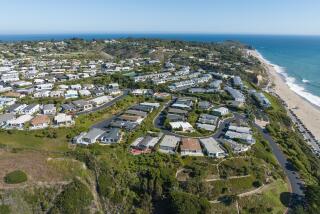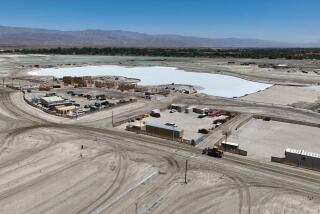Land Rush Turns Slow-Growth Malibu Into a Boom Town : Real Estate: Some say fears that the coastal enclave will pass harsh restrictions has prompted the push for development. But many more blame the county.
Along the expensive beachfronts and hills of Malibu, luxury homes have sprouted like mushrooms in recent months, signaling a building boom that has alarmed and frustrated leaders of this coastal enclave.
This is not what slow-growth advocates had in mind after voters overwhelmingly approved cityhood in June and elected a five-member City Council entirely from their ranks.
For many, the prospect of incorporation promised a quick end to a course of unbridled growth that Los Angeles County officials were widely believed to have set for Malibu.
Now, with the county thus far having succeeded in its bid to delay cityhood until March and with Malibu’s government-in-waiting unable to get a grip on growth, some advocates worry that the boom threatens to ruin their semi-rural atmosphere before they get a chance to protect it.
“We’re seeing a land rush like we’ve never seen before,” said Sara Wan, vice president of the Malibu Township Council, a slow-growth group. “Everyone wants a piece of the pie before the party’s over, and the county seems intent on giving it to them.”
According to a computer record amassed by the township council, the county has issued 186 building permits for new homes in Malibu in the last nine months, almost as many as in the previous three years. Another 1,600 applications have been submitted to build new homes and subdivide new residential lots there, the organization said.
County officials do not dispute the council’s figures, and said they could not provide any of their own because their record-keeping system is scattered among many different departments. To compile the figures, the township council built a data base of its own by seeking out information from the various county departments, members said.
But Los Angeles County authorities reject the notion that they have facilitated the recent upsurge.
“Ours is basically a ministerial function,” county planner Ron Huffman said. “If someone buys property and wants to build there, and they meet the applicable requirements, it is not for us to tell them they can’t go forward.”
The large potential for growth is all the more disturbing to anti-development advocates because of a 1986 land-use plan certified by the California Coastal Commission and what it may mean for Malibu’s ability to shape its own future.
The plan set a limit of 2,110 residential units that may be built in the Malibu area until another traffic lane is added to Pacific Coast Highway from Malibu to the Santa Monica Freeway. The roadwork is not a high priority with Caltrans and may be years away.
In monitoring construction allowed under the land-use plan, the county keeps track only of the number of building permits it issues at the end of the process, without regard to the much higher number of applications in the pipeline.
The Coastal Commission, which is severely understaffed, also makes no effort to monitor the number of applications in the process.
“What it means is that, in reality, nobody is minding the store,” Wan said. “The county can tell you what’s coming out of the process, but neither the county nor the Coastal Commission, both of which should be concerned about the building cap, can tell you what’s coming through the system.”
Critics say that if everyone who has applied is allowed to build, the construction cap may be exhausted before a new Malibu government gets the chance to decide on the kind of residential development it prefers or where it is placed.
Particularly disturbing, Malibu leaders said, is a tendency among some developers to sacrifice quality in landscaping and design in the rush to get project approval. Among the developments in the works are a number of small- to medium-sized condominium projects that slow-growth activists fear may contribute to the hodgepodge effect of Malibu’s architecture.
“It’s entirely possible that while we are bound to win the battle (for cityhood), we may lose the war,” said Peter Tomkins, a computer programmer who keeps track of the permit applications for the Township Council.
The Township Council estimates that if all current applications for houses and lot subdivisions were to be approved, 2,089 units of the 2,110-unit building cap will have already been taken. These include all permits and requests since 1986.
But county officials insist slow-growth activists have exaggerated the potential for rapid development.
Slow-growth advocates disagree.
“That’s nonsense,” said Missy Zeitsoff, a member of Malibu’s unofficial City Council. “They are ignoring the (huge) number of applications that are in the pipeline, which sooner or later--and more likely sooner--are going to make it through the approval process.”
In Malibu, it can take months to years from the time someone first sets out to build a house until it actually goes up.
Once preliminary nods are obtained from the county, prospective home-builders often face modifications from the Coastal Commission before being able to obtain a county building permit that enables them to start construction.
Some real estate brokers and land-use attorneys say cityhood supporters have only themselves to blame for the current boom.
“There’s no question that we’re seeing more development than we’ve ever had, but the people who put over incorporation are the ones who are responsible for it,” real estate broker Louis Busch said. “Right now, people are scared. They want to develop their properties, build their houses, because they don’t know if they’ll get the chance once Malibu becomes a city.”
Indeed, the rush to initiate building plans became so intense during the week before the June 5 incorporation election that, at one point, would-be builders from Malibu were lined up outside the county building department to have their plans checked.
“The push to build has been intense,” said Don Kowalewsky, a consulting geologist who has kept his Malibu office open six days a week for several months in an effort to meet the demand for services.
Further evidence of the surge can be seen at the Coastal Commission.
Despite having a jurisdiction that covers about 1,100 miles of coastline from Oregon to the Mexican border, the state panel, which meets for several days each month, often spends nearly half of its time on matters involving Malibu.
Last month, for example, 61 of the 162 agenda items involved Malibu.
“The joke is, we’re becoming the Malibu Planning Commission,” said Coastal Commissioner Madelyn Glickfeld, a Malibu resident. “The caseload involving Malibu seems to have increased logarithmically.”
More to Read
Sign up for Essential California
The most important California stories and recommendations in your inbox every morning.
You may occasionally receive promotional content from the Los Angeles Times.









